|
 |
 Beginners
Basic riding skills are the solid foundations that the Fundamental riding skills are based upon. They are the core riding skills equally valid both on or off road and are essential for safe riding in all conditions.
These skills will allow you to ride on smooth, prepared surfaces in a safe and controlled manner
Staying seated will allow you to concentrate fully on developing each basic skill until it becomes almost second nature. Don't try to concentrate on too many skills at any onetime, make one or two a priority for each ride or section of ride.
Master these cycling basics before learning the fundamentals of off-road riding in the next section. Braking.
Check unfamiliar brakes.
Before riding your bike make sure you are familiar with which lever operates which brake. Most UK bikes are set up with the front brake on the right in a simialr fashion to a motorcycle whilst most European and American bikes have the front brake on the left.
You don't want to find they are the wrong way round whilst travelling at speed.
Use no more than two fingers and preferably only one on the brake lever. This will keep as many fingers wrapped around the bars as possible giving you better control of the bike whilst braking whilst keeping you from applying too much brake or panic braking which could lead to you loosing control of your bike.
Lever setup.
Make sure that when you pull the levers as hard as possible that they levers don't hit any of your fingers on the bars. If they do, move the brake levers further towards the center of the bars until your braking fingers are positioned towards the end of the lever.
This will give you more braking power and allow you to pull the lever all the way to the bar without fouling on the fingers left on the grip.
Set the angle of the levers up so that your wrist bends naturally up slightly when you have a finger on the lever in a similar fashion to the picture to the right. This will give you a much more stable ride over rough terrain and help to reduce arm and hand fatigue.
Brake smoothly.
Make sure you apply the brakes smoothly rather than 'grabbing a handful' which can cause you to skid.
Push back lightly on the handlebars to stop your weight going forward and the back wheel getting light enough to start skidding.
If you are braking to slow down for a corner, try to have your braking finished before you start your turn.
Under stronger braking use a little more front brake but only do this in a straight line and on a good surface.
Steering and Cornering.
Try not to jerk the bars or swerve around too much especially on loose surfaces, make long sweeping turns using all of the available trail rather than short sharp ones. Steering early allows you to steer less which less effect on your balance.
As you enter a corner try to look towards the end of it and into the next section of trail. Point your head and shoulders in the direction you want to go, this will help you commit to the turn and makes learning more advanced cornering techniques easier. It is you that is making the bike turn not the other way round
At higher speeds steer by leaning the bike over rather than turning the bars.
Keep your grip on the bars relaxed, it will give you better control and be far less tiring over longer rides.
Notice in the sequence of pictures to the right how the rider has taken a smooth contiuous curve through the corner, makes sure he looks well ahead even when exiting the corner and has one finger covering each brake at all times.
This allows him plenty of time to deal with any potential problems further down the trail.
Pedal efficiently.
Try to move your feet in circles rather than just pushing down, this is a far more efficient way of pedalling as you are putting less effort over more of each pedal stroke. You don't try to move all the shopping out of the car in one go as it's just too hard, you make more trips using less total effort.
Start by putting less effort into your downward push on the pedals but extending the amount of time you put the effort in by pushing back on the pedals as they get to the bottom of their stroke. A good way of doing this is to imagine you are trying to wipe muck off your soles. Once you become comfortable doing this without having to think about it too much then start to gently push forward when the pedals are at the top. To make your overall stroke even bigger.
Keep alternating which movement you are concentrating on until you find you are pedalling in a smoothly from the 11 o'clock position all the way through to the 7 o'clock position as pictured to the right.
Gear selection.
Cycling for leisure is all about efficiency. Use a gear that you find easy to spin the pedals, you might not go quite as fast but you will go a lot further and feel less tired at the top of each hill.
Try to select gears well in advance, this allows you to pedal gently which helps the gears change easier. When you see a hill coming up, change gear whilst you are still going downhill or on the flat as gears, especially the front, don't like changeing whilst you are pedalling hard.
Try to select a gear that keeps the chain straight. When using the small cog on the front, select one of the larger cogs on the rear.
When using the middle front cog, use a gear near the middle on the back and when using the big right hand cog on the front use one of the smaller right hand ones on the rear.
Doing this ensures even wear on all your cogs and stops the chain being twisted across gears which accelerates it's wear no end.
Moving On.
Steer clear of any steep climbs or descents until you are confident you know how the bike and it's brakes handle.
Once confident with the above skills move onto the fundamental skills where your riding ability will rapidly develop.
top | safety | equipment | 5 Basic Skills 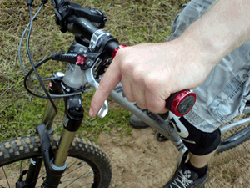 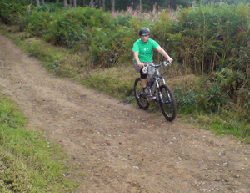 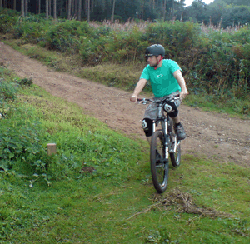 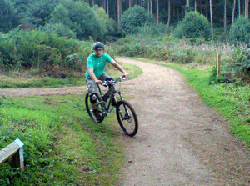 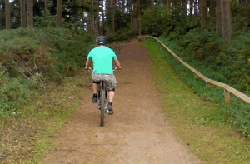 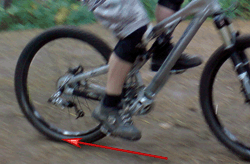 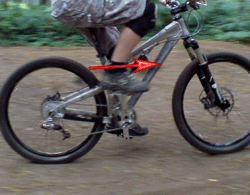 |
top | home | beginners | fundamentals | advanced | downhill | resources
Copyright ©2009 MTB Techniques | All rights reserved
The information on this site should be taken as a broad guide only and is open to interpretation and misunderstanding. You should consult a qualified instructor for more information about any of the tips given. MTB Techniques cannot accept responsibility or liability for accuracy, clarity or your interpretation of any of the topics provided. Mountain biking can be dangerous. You must make sure you understand the level of risk involved and wear suitable protective equipment whenever you ride.